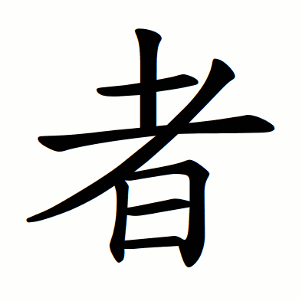者
- person;
- one who …;
Etymology
There are several theories about its origin:
Traditionally it is explained as a pictograph of stacked wood being burned, and regarded as the original form of 煮 (to boil, cook).
Another view interprets it as representing sugarcane: the upper part 耂 depicts sugarcane stalks, and the lower part 日 is derived from mouth (口 → 曰 → 日).
Originally it carried the meaning “to cook, to boil.” The sense of “person, one who …” is a later loan usage.
Usage in Korean
Common compounds / usage:
독자 (讀者) – reader (“the one who reads”)
기자 (記者) – journalist (“the one who records”)
학자 (學者) – scholar (“the one who studies”)
자 (者) as suffix, person, agent marker (similar to “-er” in English)
Words that derived from 者
- 개척자(開拓者)–colonist; settler; pioneer; pathfinder
- 공급자(供給者)–supplier
- 근로자(勤勞者)–worker
- 기술자(技術者)–engineer; technician
- 기자(記者)–reporter; journalist
- 기증자(寄贈者)–donor
- 노동자(勞動者)–worker; working people; laborer
- 당첨자(當籤者)–lot winner; prize winner
- 도망자(逃亡者)–runaway
- 독자(讀者)–reader
- 독재자(獨裁者)–dictator; tyrant
- 목격자(目擊者)–witness
- 방문자(訪問者)–visitor
- 범죄자(犯罪者)–criminal
- 부자(富者)–the rich; the wealthy; person with a lot of something
- 상속자(相續者)–inheritor; heir; heiress
- 선지자(先知者)–prophet; visionary
- 성자(聖者)–saint; holy man
- 순례자(巡禮者)–pilgrim
- 신자(信者)–believer; devotee
- 신학자(神學者)–theologian; theologist
- 양자(兩者)–both sides; both parties; being bilateral
- 예언자(豫言者)–predictor; foreteller; prophet
- 왕자(王者)–prince; champion
- 자(者)–person
- 작자(作者)–author; writer; novelist; artist; buyer; purchaser; guy; fellow
- 저승사자(저승使者)–Grim Reaper; angel of death
- 적대자(敵對者)–opponent
- 전자(前者)–earlier; the other day; the former
- 절대자(絕對者)–the Absolute; supreme being
- 주관자(主管者)–host
- 지도자(指導者)–leader; head
- 참석자(參席者)–participant
- 채무자(債務者)–debtor
- 첩자(諜者)–spy
- 화자(話者)–speaker; narrator
- 후자(後者)–latter
Additional notes
The gloss “놈” (“fellow, person”) comes from the fact that in older Korean usage 놈 was not derogatory, but a neutral word for “person.”
In Classical Chinese and Korean usage, 者 functions as a suffix or bound noun:
South Jeolla dialect example: 南原有梁生者 – “In Namwon, there was a person named Yang-saeng.”
It can also mean “the one who …, that which …”:
出乎爾者反乎爾 – “What comes from you returns to you.”
此者不當爲者也 – “This is something that ought not to be done.”
It may also appear after a noun to emphasize the subject.
Note: The “자” in 男子 (man) and 女子 (woman) is not this 者, but 子 (child, son). Historically, 男子 and 女子 literally meant “male child” and “female child.”
Alternative forms
In Korean hanja and occasionally in Japanese and Vietnamese, an additional 丶 stroke is written at the bottom right corner of 耂 above 日, which is the historical form found in the Kangxi dictionary. In other regions, the additional 丶 stroke has been omitted.
In Unicode, the dotted and undotted forms are unified under the same code point. By contrast, some characters such as 緒 (U+7DD2, no dot) and 緖 (U+7DD6, with dot) retain separate code points.
U+FAB2: Alternative form used in North Korea without additional 丶 stroke below 耂.
U+FA5B: Japanese kyūjitai with additional 丶 stroke below 耂.
U+2F97A: Variant traditional form used in Taiwan with additional 丶 stroke below 耂.
- 十大日 (JKA)
- ⿱ 耂 日 (G H T J V)
- ⿱⿸ 耂 丶 日 (K)
